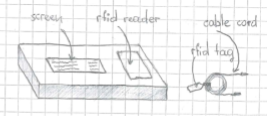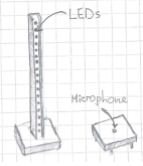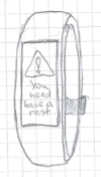Phone and cup holder
11 March 2023Tech projects
Mountains backlight
06 July 2022Tech projects
Lego Saturn V Blast off
23 January 2022Tech projects

This project was done in group of 5 people in the first year course in the University.
Hearing can be identified as the ability of the ear to perceive sound by detecting vibrations and changes in the pressure, and convert sound waves into information the brain understands and interprets as sounds. Sounds above 88 dB are considered to be harmful and can damage hearing. Musician are exposed to the loud noise and are more likely to have a noise-induced hearing loss. As a human ear has a vital role, our group aims to help the DJ's to prevent the ear damages.
The topic for our project is "Musicians and health issues" and the target group are "DJ's".
How can we use Arduino to help the DJs to prevent ear damages which can occur from loud noise.
We identified our concept as a mini star map in a watch-like form. Stars are associated with dreams, eternity, ordered system and prediction of future. People also use star sky to predict future based on the present data, like position of stars, planets, etc. Our mini star helps to identify the sound's level and to understand the consequences of it.
We conducted three semi-structured interviews and one direst observation in the field to collect the information from the target group. Observation gave us understanding of the user's job role and his/ her activities, while the interview helped us to find out the problems and the preferences of the user. Three-semi structured interview was taken during evaluation.
Problem and prototype 1Problem and prototype 2Prototype 3
Problem 1: missing by the users separate parts of musical equipment when they are on the way to rehearsal/concert.
Prototype 1: Our solution is to create a checklist of the equipment by putting RFID stickers on the items and scanning them with Arduino device. The output would inform the user about scanned item and remind them of any missing items.

Problem 2: damaging of hearing as a result of playing loud music on the concerts/rehearsal.
Prototype 2: A broad variety of our solutions includes a lamp, which would change colors for informing the user about dangerous level of volume. Thus, the user can take precautions for it.

Prototype 3: The second solution to problem 2 was to create wearable, small, lightweight device that user could put around his/her hand (watch or bracelet). It would warn the user about dangerous level of sounds by vibrating and showing dB value on a built in mini-screen.

As the user need and preference we decided to create a wristband and case. This is how our prototype has evolved throughout the design process:
Case: Can charge wristband color/settings; Will show dB level in the room with screen or 7 segment display. (Can give some warnings about loud music and report about time that breaks up the limit during the day). Wristband: Can give warning with LEDs or vibration depending on which function user choses by pressing a special button. Prototype can give a simple signal to inform about high sound level without distracting the DJ. Wristband and Case can communicate via bluetooth: Wristband will send data about the sound and Case will handle the data.
Our final product consists of two devices:
A wearable bracelet that notifies the user when the sound around him/her is too loud by vibrating and/or changing its colour. The LEDs are placed in a center around a microphone-sensor. Along with these the product contains a vibration motor, battery, two buttons, switch, a Bluetooth module, charging module and cables connecting everything together.
Our second device is a tangible case with a lid on the top. On the lid we have a screen which is used to inform the user about how long you have been listening to/playing different sounds levels.
A case has a place inside for the wristband and earplugs. The device receives the dB values from the bracelet through Bluetooth connection and calculates the duration of each sound level that was detected. It prints these values on the screen with relation to letters G for good sound level, M for medium sound level and L for loud sound level. It also shows the dB on the bottom of the screen. Like the bracelet it has also a charging module to charge it up with.